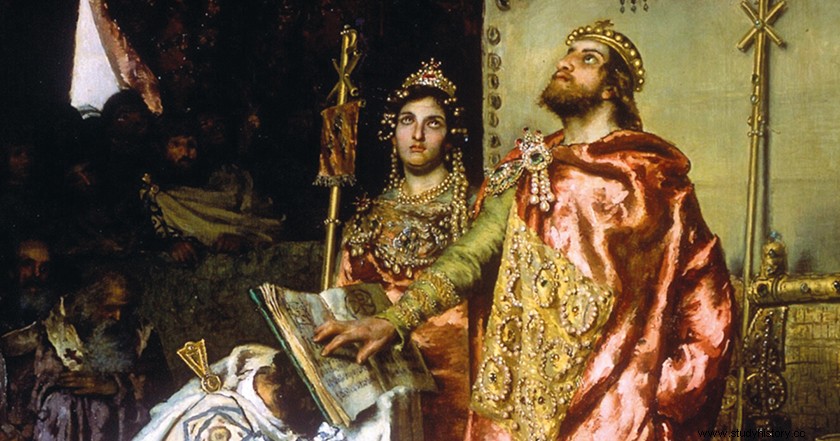
Although it sounds a bit weird, it can be said without fear of being wrong that the Visigoths are in "fashion". For nearly three centuries, the Visigothic kingdom of Hispania led the passage from antiquity to the Middle Ages in our country. Despite this, there were very few publications in the 20th century. A fact that has been amply corrected in recent years by both historians and authors of historical novels. Thanks to them we can currently enjoy several readings of proven quality. Without going any further than what I want to talk about today, which has been brought to our bookstores by Editorial Almuzara:The Visigoths. History and Archeology of the Visigothic Hispania of Luis del Rey.
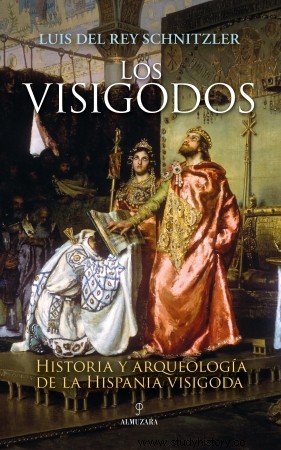
Visigothic archaeology.
I cannot deny that I like the approach that Luis del Rey has given to his work. Visigothic archeology It is the great forgotten in the deposits of Spain. This fact has affected that the history of the Visigoths is told with certain disconnections. In short, we have more evidence of Visigothic writings than of archaeological remains.
Without going any further, we usually keep in mind that the Romans were a society of cities and instead we think that the Visigothic kingdom became much more rural. According to Luis del Rey, this dichotomy is not so clear. Córdoba, Seville, Mérida, Barcelona or Toledo, to give a few examples, had a notable occupation in the Visigothic period.
One of the best examples is Barcelona. The Roman Barcino it was converted into the first Visigothic capital of Hispania, even before the founding of the Visigothic Kingdom of Tolosa on the other side of the Pyrenees. An aspect that denotes the importance in this period is the discovery of two episcopal seats. The first under Plaza del Rey and the Gothic Cathedral of Santa Eulalia , where remains of a part of the façade have been found, the foundations of a possible hall to celebrate synods, and especially a spectacular baptismal pool with a large kicked cross inside. The other find is more recent and under the subsoil of the Basilica of Santos Justo y Pastor , located about 200 m from the previous one. Before the III Council of Toledo in the year 589, they could well have belonged to the two Christian creeds practiced by the Visigoths; the Arian and the Roman Catholic.

King's Square (Barcelona)
The second of the great cities that Luis del Rey visits in search of Visigoth remains, it is the most important city in Hispania in late antiquity. Emerita Augusta , capital of the Diocese Hispaniarum from the time of Emperor Diocletian. In the fifth century AD C. the barbarian peoples took control of it, first Alans and then the Swabians. The latter made it their ephemeral capital during the short reign of Requila. A century later, the Visigoths during Agila's reign possibly also made it their capital. Various remains have been found in the city, such as in the Martyrial Basilica of Santa Eulalia in honor of the patron saint of the city, including pilasters, decorated friezes, capitals and tombstones. Although the most interesting was found in the archaeological zone known as la Morería . There, along with the remains of the Roman wall, Visigoth dwellings have been found that used the old domus Roman houses, a Roman ranch, a Visigoth dwelling, denotes the economic decline of the period.
But the great missing link of the Visigoths is Toledo . Capital of the kingdom since the time of Teudis, or that of his successor Atanagildo (554-567). The truth is that Leovigildo, the successor of the previous one, makes it his habitual residence. Here the absence of archaeological remains standing is almost total. It is only bet, and it is discussed, that there is a stretch of Visigothic wall on the Cuesta de la Granja. Nothing else.
If we go to the written sources, mainly the minutes of the councils, we can deduce some things. The city had three great churches; Holy Mary , Holy Apostles Peter and Paul , and Santa Leocadia . In addition to the great palatine city which Leovigildo had erected in the image and likeness of his neighbors, the Eastern Romans, from whom he literally copied his royal ceremonial. Nothing found. Everything is indications and speculations more or less consistent. Most archaeologists bet on the presence in the Vega Baja archaeological zone of a large part of this palatine structure, there are also detractors who deny it, mainly supported by the absence of walls. The Visigoth remains found in the area have been exhibited in city museums, such as the Museum of the Church of San Román . In addition to serving to support other later constructions, both Muslim and Christian.
The importance of religion in the Visigothic world.
During the Visigothic period, religion became the main axis of society. The church exercised political, social, judicial and economic control, it was the true companion of the Visigoth kings. We must not forget that the Visigothic church underwent a profound transformation throughout the almost three centuries that they dominated in Hispana, the Visigoths arrived as Arians and ended up becoming champions of Roman Catholicism. According to the chronicles of the time, Luis del Rey tells us that there were about 70 episcopal sees distributed throughout the Peninsula and Narbonne. Six of them were the main ones and acquired the role of metropolitan headquarters; Toledo, Mérida, Seville, Tarragona, Braga and Narbonne.
These metropolitan sees must have been equipped with episcopal complexes of different sizes according to their importance. Common elements should be found in all of them:The Basilica or Cathedral It was a meeting place for the faithful, they were normally constructions with a Latin cross plan and the largest had three naves separated by arches topped with a main apse, square or semicircular; Baptistry , place of baptism of the faithful equipped with a large baptismal font; Episcopal Palace , or principal residence of the Bishop; and finally a Aula for the celebration of the synods .
The obvious thing is that there are few remains of the main ones mentioned above. But if we can bring us closer to one of a smaller size, and one of those that have been preserved in the best condition on the Peninsula. In this way, Luis del Rey invites us to visit the Egara Episcopal Complex , near Barcelona in the industrial town of Terrassa. It is made up of three churches, all three with different Visigoth vestiges; apses, tombs, columns, baptismal pools and especially a magnificent mural painting from the 6th century that is unique in Spain. The one of San Miguel is the one that maintains an aspect closest to the original from the Visigoth period.
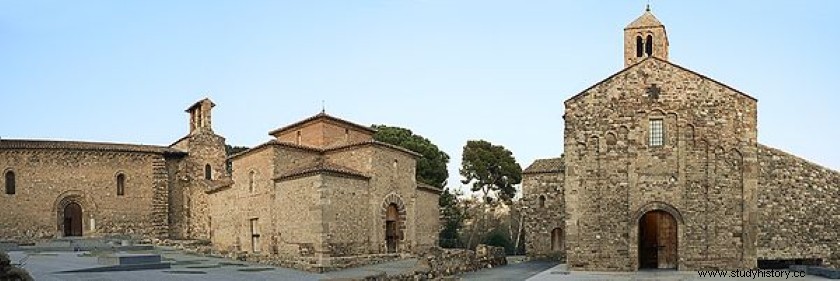
Visigoth episcopal complex of Egara
Although there are no large episcopal complexes, the churches are the best present we have preserved from the Visigoth Kingdom. Many of them have obviously been restored over the centuries, incorporating architectural elements of different artistic styles. In Spain some of the most representative are:San Pedro de la Nave (Zamora), San Juan de Baños (Palencia) or Santa Comba (Ourense). Portugal also has outstanding examples:Sao Torcato (Guimarães) or Sao Pedro de Balsemao (Viseu). Luis del Rey dedicates to all of them an interesting chapter, to discover the secrets hidden in the drawings carved in its stones, geometric, vegetal, zoomorphic and even anthropomorphic motifs.
Hermits and gravediggers.
The hermits have their origin in the Egyptian desert in the fourth century. The Bible itself encouraged this way of serving God, reaching perfection and eternal forgiveness after dispossessing all possessions and dedicating his life completely to God. In the following centuries many men, and some women, decided to follow this practice in the vast Christian territories.
Visigothic Hispania was no stranger to this trend, despite being persecuted by the Visigothic ecclesiastical authorities. Canon 5 of the VII Council of Toledo, held in the year 646, criticized the attitude of the hermits, who, without being instructed by the rules of the Church, dared to meditate and engage in direct conversation with God. Some hermits were persecuted and forced to live together in Visigothic monasteries.
Their main refuge was the caves, austere constructions, sometimes even excavated by themselves and reconditioned to live. Luis del Rey reveals some examples to us; such as the Hermitage of Urarte (Álava) or the Cave of San Genadio (Lion). Some of the caves, despite the persecutions, became a true refuge for communities of hermits. Over time, after the fall of the Visigothic Kingdom in the year 711, with the arrival of the Muslims, they gradually became authentic churches carved out of stone. Some are still in use today, such as, for example, in the Valderredible area, in the south of Cantabria. That is precisely the area of Spain where we will find more cave hermitages, along the entire southern part of the Cantabrian Mountains.
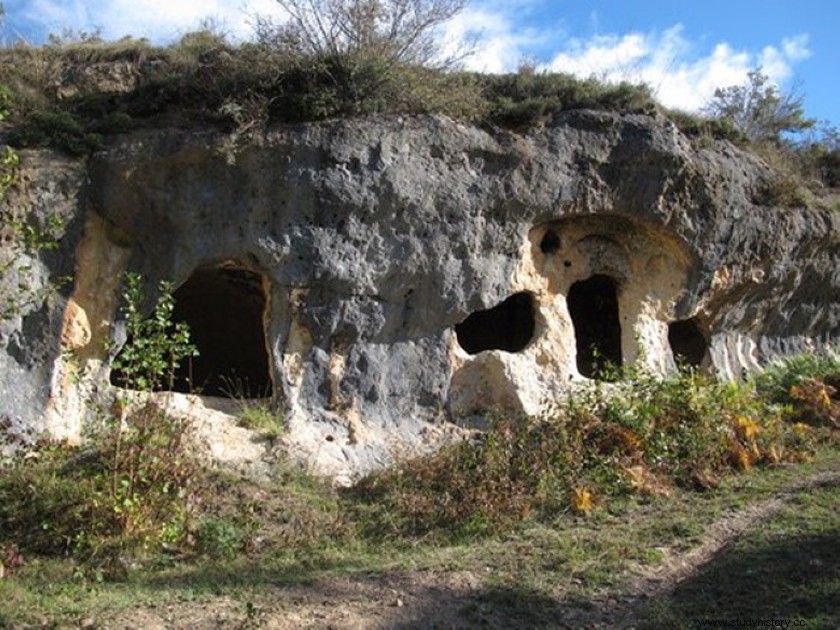
Hermitage of Urarte
The Visigoths buried their dead outside the cities, a Roman custom. Around the aforementioned churches there are numerous tombs. Most of them attached to the walls outside the church, since burials inside the church would most likely be prohibited. Despite this, some have been located inside them, and even more strange is the location of some tombs in the very apses of the churches. It is evident that those buried there must have been prominent figures, the bishops are a good option, the other option would provide an answer to another of the great questions, where were the Visigoth kings buried?
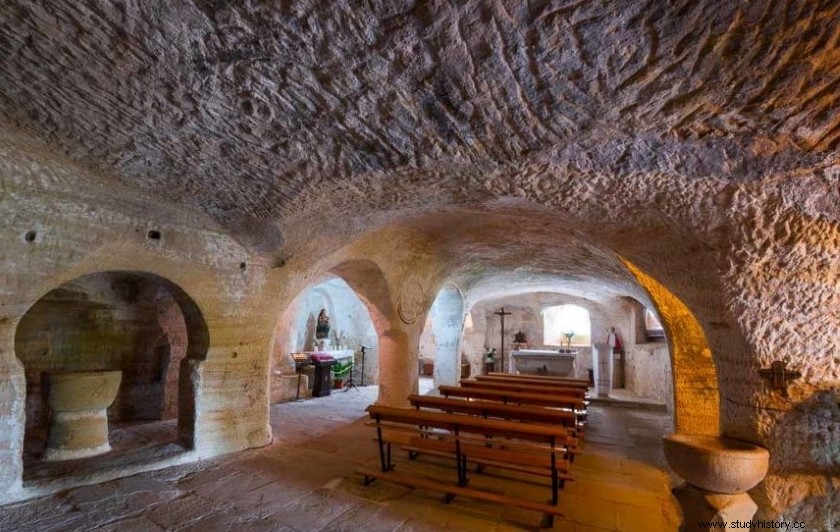
Cave church of Santa María de Valderredible.
The answer to that question is very complex. In Visigoth Hispania the kings did not build the great mausoleums of their Ostrogothic counterparts, remember in Ravenna that of Theodoric the Great. Through the texts we know where many kings died, but none name where their bodies were deposited. Let's start speculating.
According to later medieval sources, such as the 10th-century one by the great Arab historian Ahmad ibn Muhammad al-Razi, known as the Chronicle of the Moorish Rasis, Some Visigoth kings were buried in a royal pantheon located in the old Visigoth church of Santa Leocadia, not to be confused with the current one located in the city of Toledo. Let us remember that the Visigoth has not been located.
Others chose their spiritual retreats to be buried. One example is King Chindasvinto (642-653), who was apparently buried in the monastery of San Román de Hornaja (Valladolid). There, during an archaeological campaign, a sarcophagus was discovered containing the skeletal remains of a man and a younger woman. The easy thing to do, given the lack of evidence, is to speculate that it was those of Chindasviento and his wife Reciberga, forgive me for the paragraph, what a name they gave the girl.
Leaving aside the kings, a good place to visit are the most famous Visigoth burials. The Visigoth period necropolis excavated in stone . Very little studied, since they have remained for centuries in the open in large cemeteries located in the middle of nature, therefore, very close to the friends of others who have continually desecrated their remains. In the vicinity of the cave churches in the south of the Cantabrian Cornice there are many, such as San Pantaleón in Valderredible . But also distributed in other corners of the Peninsula, such as the Visigoth necropolis of Ercávica (Cuenca). In this section, Luis del Rey does not stop wondering about a transcendental question. How many of those buried there were Visigoths, how many Hispano-Romans, and how many Hispano-Visigoths, the latter being born with Recaredo in the year 589?
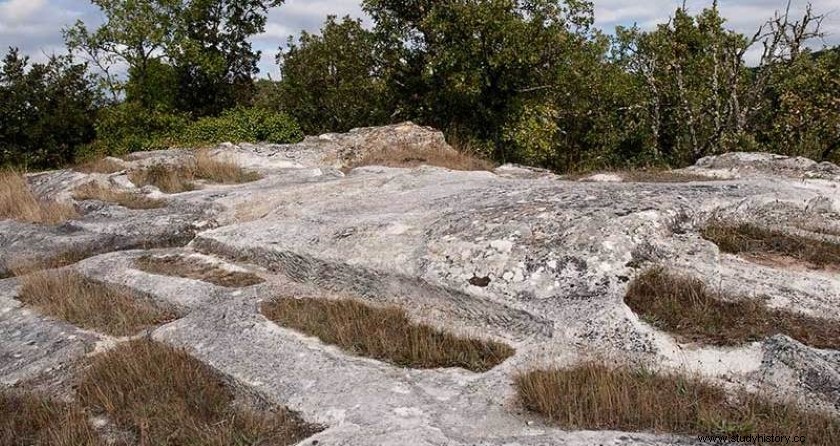
Visigoth necropolis of San Pantaleón
In short, one of the great conclusions, after reading this book by Luis del Rey, is that we begin to know many things about our Visigothic past. But we still need to know more, there are numerous questions, which we will leave in the hands of young historians, who have a great platform in the Visigothic Kingdom to continue investigating our history. Meanwhile, don't stop enjoying this particular vision of The Visigoths. History and Archeology of Visigothic Hispania by Luis del Rey Schnitzler
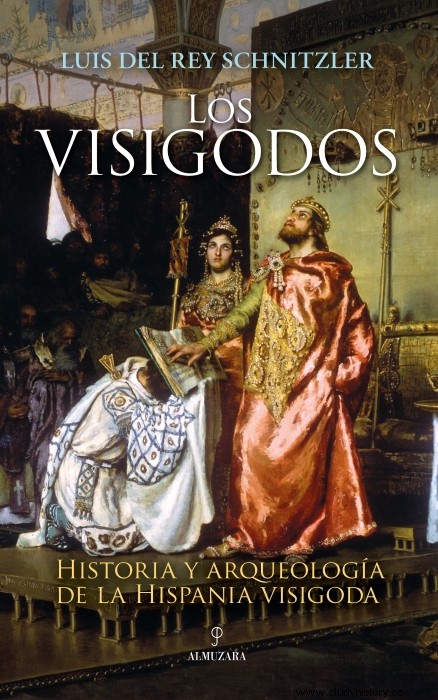
The Visigoths in Historioteca
